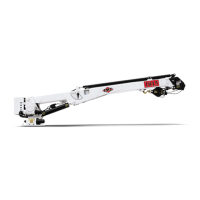6-2 SECTION 6. GENERAL REFERENCE99903514:TELESCOPIC CRANE:
Inspection Checklist
OWNER/COMPANY
CONTACT PERSON
CRANE MAKE & MODEL
CRANE SERIAL NUMBER
UNIT I.D. NUMBER
LOCATION OF UNIT
CRANES
TYPE OF INSPECTION (check one)
HOUR METER READING (if applicable)
DATE INSPECTED
INSPECTED BY (print)
SIGNATURE OF INSPECTOR
DAILY (if deficiency found)
MONTHLY
QUARTERLY
ANNUAL
TYPE OF INSPECTION
NOTES:
Daily and monthly inspections are to be performed by a “competent person”, who is capable of identifying existing and predictable hazards
in the surroundings or working conditions which are unsanitary, hazardous, or dangerous to employees, and who has authorization to take
prompt corrective measures to eliminate them.
Quarterly and annual inspections are to be performed by a “qualified person” who, by possession of a recognized degree, certificate, or
professional standing, or who by extensive knowledge, training and experience, successfully demonstrated the ability to solve/resolve
problems relating to the subject matter, the work, or the project.
One hour of normal crane operation assumes 20 complete cycles per hour. If operation exceeds 20 cycles per hour, inspection frequency
should be increased accordingly.
Consult Operator / Service Manual for additional inspection items, service bulletins and other information.
Before inspecting and operating crane, crane must be set up away from power lines and leveled with stabilizers deployed according to the
crane manufacturer’s directions.
DAILY (D): Before each shift of operation, those items designated with a (D) must be inspected.
MONTHLY (M): Monthly inspections or 100 hours of normal operation (which ever comes first) includes all daily inspections
plus items designated with an (M). This inspection must be recorded and retained for a minimum of 3 months.
QUARTERLY (Q): Every three months or 300 hours of normal operation (which ever comes first) includes all daily and
monthly inspection items plus items designated with a (Q). This inspection must be documented, maintained, and
retained for a minimum of 12 months, by the employer that conducts the inspection.
ANNUAL (A): Each year or 1200 hours of normal operation (which ever comes first) includes all items on this form which
encompasses daily, monthly and quarterly inspections plus those items designated by (A). This inspection must be
documented, maintained, and retained for a minimum of 12 months, by the employer that conducts the inspection.
1
REV: 11-22-11
NOTICE
The user of this form is responsible in determining that these
inspections satisfy all applicable regulatory requirements
20111122
D 1 Labels All load charts, safety & warning labels, & control labels are present and legible.
D 2 Crane Check all safety devices for proper operation.
D 3 Controls Control mechanisms for proper operation of all functions, leaks & cracks.
D 4 Station Control and operator’s station for dirt, contamination by lubricants, & foreign materials.
D 5 Hyd System Hydraulic system (hoses, tubes & fittings) for leakage & proper oil level.
D 6 Hook Presence & proper operation of hook safety latches.
D 7 Wire Rope Inspect for apparent deficiencies per applicable requirements and manufacturer’s specifications.
D 8 Pins Proper engagement of all connecting pins & pin retaining devices.
D 9 General Overall observation of crane for damaged or missing parts, cracked welds & presence of safety
covers.
D 10 Operation During operation, observe crane for abnormal performance, unusual wear (loose pins, wire rope
damage, etc.). If observed, discontinue use & determine cause & severity of hazard.
D 11 Remote Ctrls Operate remote control devices to check for proper operation.
D 12 Electrical Operate all lights, alarms, etc. to check for proper operation.
D 13 Operate anti-two-blocking or two-block prevention devices to check for proper operation.
STATUS
FREQUENCY
, R,
X, NA
INSPECTION DESCRIPTIONKEYITEM
= SATISFACTORY
R = RECOMMENDATION (Should be
considered for corrective action)
NA = Not Applicable
X = Deficient (Note: If a deficiency is found, an immediate
determination must be made as to whether the deficiency
constitutes a safety hazard and must be corrected prior to
operation.)
Anti Two-Block or
Two-Block Damage
Prevention

